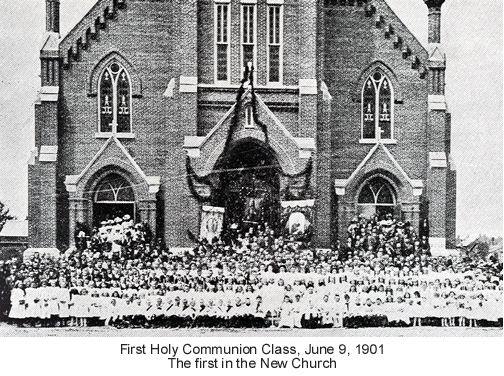History Of. St. Peter's Congregation — 1876-1901 First 25 Years
[Reprinted from Diamond Jubilee St. Peter’s Congregation, Stevens Point, Wisconsin, 1876-1951.]
St. Peter's Roman Catholic Congregation was organized in 1876. The founders were Polish immigrants who wished to have a church of their own, with pastors who could speak their native tongue. Perhaps a few interesting facts, and a short outline of conditions at that time, would give the reader more understanding of the trials and tribulations of these hardy pioneers. Let us begin in the 1850's.
Wisconsin was largely a wilderness in the early 1850's. It was not until the later part of the decade that the Indian tribes were quieted and banished to reservations. The title of Indian lands was not dearly vested in the State until about 1856. The Civil War (1861-65) stopped practically all immigration to this country and consequently, not very many immigrants came here during that period of unrest. The Homestead Act of 1862, however, lured many settlers to the fertile lands in Portage County.
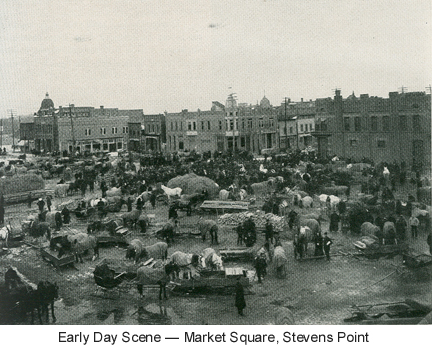 The lumbering industry, which was operating in this vicinity as early as 1839, but was not in full bloom until the 1870's, employed many of the settlers in its various phases of operation. Some of the immigrants joined the log-drives on the rivers in early spring, or became lumberjacks in the pine forests during the winter months, thereby adding to their small income. Farming was not common in Portage County until after the 1862 Homestead Act made cheap land available.
The lumbering industry, which was operating in this vicinity as early as 1839, but was not in full bloom until the 1870's, employed many of the settlers in its various phases of operation. Some of the immigrants joined the log-drives on the rivers in early spring, or became lumberjacks in the pine forests during the winter months, thereby adding to their small income. Farming was not common in Portage County until after the 1862 Homestead Act made cheap land available.
Stevens Point was a logical center for lumbering operations, being on a smooth stretch of the Wisconsin River, between rapids, and centering well between the major lumbering projects in the famous and fabulous "Pineries" of the early days. By 1847 there were already some houses in the settlement, and a wood and earth dam was completed about that time. In 1850, the village was incorporated, and became famous as the gateway to the Northern Pineries. Practically no wagon roads existed to the North, and everything took to the river for transportation from the "Point". Only a few brave, pioneering women were living here, as living conditions were of the most primitive kind.
Plover was then the seat of Portage County, although it was moved to Stevens Point in 1869 after a most controversial ballot.
History reveals that the first Polish family to settle in or near Stevens Point was that of Michael von Koziczkowski, who came in 1857. He arrived here with his wife and family; left his family here, and went on to Big Bull Falls (Wausau) in search of good land for farming. After finding the land unsatisfactory there, he returned shortly and settled near Polonia. A year later, several others came to Stevens Point vicinity, notably: Adam Klesmit, John Zynda and Joseph Platta, with their families. In 1859 we hear of the Dzwonkowski's, Wojak's, the Lukaszewitz's, Jazdziewski's, and Werachowski's, the Kuklinski's, Kleman's, Reszczinski's and Szelbracikowski's. Most of these families settled in Ellis, Polonia or Stevens Point.
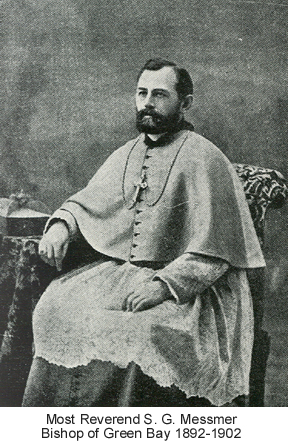 Around 1863, about 40 Polish families farmed on land near Ellis, and the community was popularly called "Poland Corners". This was one of the first Polish settlements in the United States. Being Roman Catholics, these people attended St. Martin's Church in Ellis or St. Stephen's Church in Stevens Point, which was then the only Catholic church in the city.
Around 1863, about 40 Polish families farmed on land near Ellis, and the community was popularly called "Poland Corners". This was one of the first Polish settlements in the United States. Being Roman Catholics, these people attended St. Martin's Church in Ellis or St. Stephen's Church in Stevens Point, which was then the only Catholic church in the city.
Many of the Polish immigrants acquired farming land through the Homestead Act, purchasing it for as little as eleven cents per acre. They were tillers of the soil in their homeland, and naturally desired to continue in this work for their livelihood in their adopted country.
The railroad at this time ended at Berlin, Wisconsin, and these courageous Poles came to Stevens Point in ox-carts or by stage line from that point. It must have been quite an undertaking to travel with a large family, clothing, food, and household goods over the poorest kind of road, through the primeval wilderness which was Wisconsin in the 1850's. Records show that Koziczkowski came with his wife and nine children.
During the late 1860's the Wisconsin Central Railroad was building a line from Menasha to Lake Superior, which was to pass through Stevens Point. After many difficulties, the road was built to the city, and equipped with rolling stock. The first train of cars reached Stevens Point on November 20, 1871. During the winter, and the following summer, the tracks were continued in a northerly direction for more than one-hundred miles, mostly through unbroken forest lands.
The advent of the railroad to the city was a great event, contributing much to the growth and settlement of the area. In 1876 a branch line was built to Portage, placing the city in a very favorable position as to commerce and transportation. The growth of population in the area received great impetus, so that in 1876, the population of Portage County had grown to 14,876 and that of Stevens Point to slightly over 3,000.
Catholics of other nationalities lived in or near Stevens Point in the early 1850's. Records show that the first Holy Mass was offered in the city in 1853. This was celebrated in a schoolhouse in the 400 block on Clark Street. During the following years, a Father Godfrey from Green Lake County attended the spiritual needs of the Catholics in the city. He offered mass in the Bennett home on Water Street, in the Brabant home on Franklin and First Street, in the Simmons home on Jordan Road, and later rented a shop on North Second Street, where the sacrifice of mass was offered for some months.
Early in 1856, the Catholics began collecting funds to purchase a site whereon they could build a church. That same year, one acre of land on Clark Street and Cross Street was deeded to Bishop Henni of Milwaukee, the diocesan headquarters at that time.
Father McGee became the first pastor of St. Stephen's Church, which was built on the site. In 1857 he was succeeded by Father Charles Stehle, and later by his brother, Father Nicholas Stehle, who remained as pastor until 1860.
In 1860, we hear of the first Polish priest in Stevens Point, and probably the first Polish Priest in the United States. He was Rev. John Polack, pastor of St. Stephen's church from July 20th, 1860, to March of 1862. Father Polack was born of noble parents in Poland in 1818, and came to this country because of difficulties with the Prussian administration in his native land. He did much to encourage Polish families to settle in Portage County.
During his pastorate at St. Stephen's, he also attended to the spiritual wants of St. Martin's Congregation in Ellis, and visited with the Polish families there. Paul Lukaszewitz, one of the founders of St. Peter's parish, served mass for Father Polack, and frequently traveled with him on his many visits. It was during his pastorate also, that Bishop Henni of Milwaukee, came to Stevens Point and administered the sacrament of Confirmation for the first time.
Failing health compelled Father Polack to resign. He retired in March of 1862 and entered Sister's Hospital in Milwaukee, where he passed away two months later.
By 1863 the number of Polish families in "Poland Corners" increased to over forty, and crowded St. Martin's Church to overflowing. They petitioned Bishop Henni to permit the organization of a Polish congregation. The Bishop approved this move heartily, and sent them Rev. Bonaventure Buczynski the following year. Father Buczynski helped to organize the parish and supervised the building of a church.
Although these Polish pioneers were comparatively poor, they were very generous to the church.
Before the end of the year the structure was completed. The site was not far from St. Martin's Church in Ellis, conveniently located for the majority of the parishioners. They decided to call the congregation "St. Joseph's".
During the following years the Polish settlers continued to come to Stevens Point and Portage County. Many of the new arrivals settled in the area north and east of the city, cleared the land and planted crops. Being deeply religious, and desirous of attending Holy Mass and receiving the Sacraments of the Church, they traveled by ox-cart, horse-and-buggy, or walked many miles to the church in "Poland Corners" or to St. Stephen's in the city. The hardships of severe winter cold and snow, almost impassable roads and trails, and the storms and heat of summer did not deter them from keeping faithfully the Sunday mass obligation. It soon became evident that more facilities for religious devotion must be provided for the everincreasing Polish Catholic population in the area.
In 1874, Rev. J. Dombrowski was sent to Portage County to organize another Polish parish, and to build another church. As many of the farmers lived to the north of the city and had no nearby place of worship, the new church was built in the Town of Hull, about four miles north of the city. This was St. Casimir's Church, popularly called "The Chapel", because of its small size and dimensions.
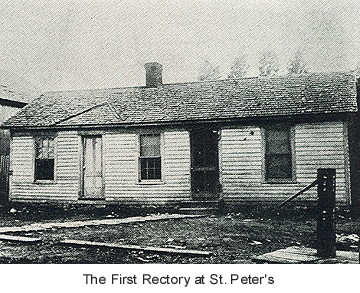 Many families transferred to this new parish from St. Joseph's in "Poland Corners" and from St. Stephen's in Stevens Point. In a short time the small "Chapel" was so overcrowded that it became necessary again to create facilities for the Polish Catholics.
Many families transferred to this new parish from St. Joseph's in "Poland Corners" and from St. Stephen's in Stevens Point. In a short time the small "Chapel" was so overcrowded that it became necessary again to create facilities for the Polish Catholics.
As Stevens Point was growing larger, and embraced a sizeable Polish population, Bishop Henni sent Father Bogacki here in June of 1876, to see what could be done about organizing another Polish parish. Father Bogacki called a meeting in St. Stephen's school, attended by the representatives of about fifty Polish families from the city. At this meeting, it was agreed to organize a new parish to be called St. Peter's. A fund totaling $800.00 was raised, with which four lots and a house were purchased from Mr. Emil Peickert. The lots extended from North Second Street to North First Street, fronting on Fourth Avenue. The house was used as a church for a short time, but was later remodeled into a rectory. When a new rectory was built in 1882, the house was sold and moved directly across the street from the church, where it became the residence of the Felix Kamrowski family for many years.
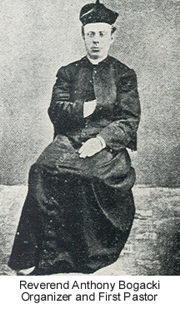 In August, 1876, work was started on a church structure which cost $3,000.00. This was a wooden, frame building that was improved and remodeled in later years to become a fine substantial structure.
In August, 1876, work was started on a church structure which cost $3,000.00. This was a wooden, frame building that was improved and remodeled in later years to become a fine substantial structure.
Father Bogacki remained as pastor of the congregation until April of 1877, just a little less than one year. St. Peter's had many pastors during the next few years, none of whom remained for a long period.
Rev. January Czarnowski arrived in May, 1877 and remained until September of the same year. Rev. Adalbert Burkowski served from September to the middle of May, 1878. From May to October of that year the parish had no resident pastor. However, in October, Father Josephat Walun took over the pastorate, coming here from the "Chapel" in Hull. He organized St. Peter's Rosary Society shortly after coming here in 1878. 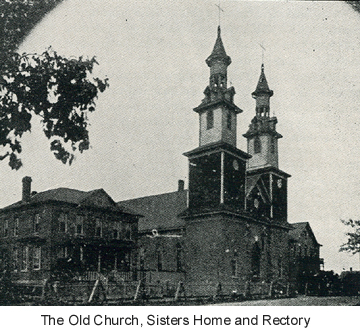 On the 12th of September in 1880, he called a meeting of the men of the parish and organized St. Peter's Society, which was very active in parish affairs for many years.
On the 12th of September in 1880, he called a meeting of the men of the parish and organized St. Peter's Society, which was very active in parish affairs for many years.
Due to ill health and misunderstandings, he retired in September of 1881. He remained in Stevens Point, however, and lived in the home of one of the parishioners for two months, until his death on November 29th. He was buried in St. Casimir's Cemetery in Hull.
During Father Walun's illness and retirement, Father J. J. Zawistowski took over the duties of pastor, but left here shortly after the death of Father Walun.
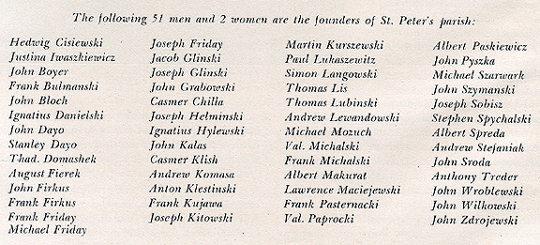
For about a whole year following the death of Father Walun, the parish again found itself without a resident pastor. Then, in November of 1882, Rev. E. J. Slowikowski, evidently an aggressive and forward looking priest, took over the task of guiding the parish. He immediately started construction on a new rectory, which cost about $2,500.00. It was built just East of the church on the corner of North Second Street and Fourth Avenue. He instituted a new men's parish organization, the Sacred Heart Society, in 1883. This Society endured for many years. Also in 1883, he incorporated the congregation under Wisconsin State laws. He remained as pastor until May, 1884.
Rev. Anthony Lex became pastor, following the transfer of Father Slowikowski. He served what proved to be the longest term of any of his predecessors, remaining for four years and five months; or until November, 1888.
Father Lex improved the church immensely, veneering the wooden structure with brick, and renovating the exterior. He also instituted the first parochial school in St. Peter's history.
In 1887, he purchased a wooden public school building from the city, along with four lots on Washington Avenue for $1,000.00. Shortly after, he persuaded Rev. Vincent Barzinski, C.R., pastor of the large St. Stanislaus Congregation in Chicago, to come here to bless the school. Father Lex arranged with the Sisters of Notre Dame in Milwaukee to teach and operate the school. The building was one story high and provided three classrooms.
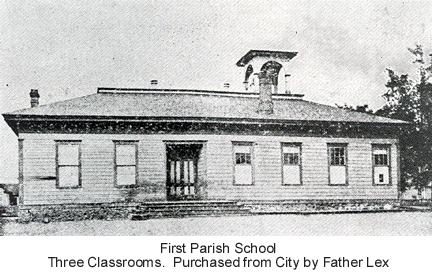 Father Lex was succeeded by Rev. Walter Grabowski, who remained here for over two years. The parish continued to grow in size during this period, resulting in the enlargement of the church at a cost of over $1,200.00. A fine home for the sisters was erected in 1890 at a cost of $2,400.00. It was built just West of the church on the corner of North First Street and Fourth Avenue. Being a brick-veneered, frame home of two stories, it provided ample room for the nuns who taught in the school.
Father Lex was succeeded by Rev. Walter Grabowski, who remained here for over two years. The parish continued to grow in size during this period, resulting in the enlargement of the church at a cost of over $1,200.00. A fine home for the sisters was erected in 1890 at a cost of $2,400.00. It was built just West of the church on the corner of North First Street and Fourth Avenue. Being a brick-veneered, frame home of two stories, it provided ample room for the nuns who taught in the school.
Father GraBowski was transferred to LaSalle in January of 1891. The pastor from that city, Rev. Zygmunt Wozny, assuming the pastorate at St. Peter's.
During his term, he organized St. Stanislaus's Society in October, 1891. He also strengthened the steeples of the church and remodeled the towers so that a bell could be mounted therein. For the first time in history, Stevens Point heard a bell announcing the services in St. Peter's Church. A new main altar was purchased and erected in the sanctuary, greatly beautifying the interior. Evidently, the parish prospered through the generosity of the parishioners, under Father Wozny's guidance.
Rev. Quiryn Zielinski succeeded Father Wozny as pastor in May of 1894, coming here from Menasha. During his pastorate, we first hear of a generous donation from the Rosary Society, the fore-runner of many which this society has made through the long years of its existence. This gesture enabled Father Zielinski to remodel and renovate the interior of the rectory, thereby adding much to the comfort and appearance of the home.
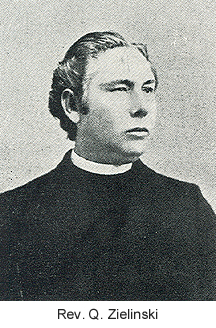 St. Rose's society was organized by Father Zielinski in June, 1894, attracting many of the younger women of the parish into its membership.
St. Rose's society was organized by Father Zielinski in June, 1894, attracting many of the younger women of the parish into its membership.
Father Zielinski purchased more land to enlarge the cemetery which the parish acquired some years before; this being St. Peter's cemetery on the Wisconsin River, just North of the present Bukolt Park. The enlarged tract was platted into lots and laid out so that there was a good semblance of order. His Excellency, Bishop Messmer came here on September 29th, 1895 and blessed the ground.
It was in 1895 also, that the Sisters of Notre Dame relinquished operating the parish school. The pastor engaged two lay teachers, Miss Martha Michalski and Miss Valeria Lukaszewitz to teach. They remained for the complete term. In 1896, however, the Sisters of St. Francis, from Milwaukee, arranged to operate the school. They remained in charge until the organization of St. Joseph's convent in Stevens Point, some years later.
On the 18th of October, 1896 a catastrophe occurred which rent the heart of every member of the parish. Shortly after Vespers on that memorable Sunday, the church burst into flames and was consumed by fire. The rectory, which stood just East of the church, on the corner of North Second Street, was so badly damaged by the fire as to make it a total loss. The limited equipment of the local fire department was sadly inadequate to cope with the conflagration, and everything was lost!
Gone was the beautiful church which they worked so hard to build! Gone was the rectory, and all the fine furnishings! Everything was destroyed! This was a terrible blow! The congregation gazed at the holocaust and sadly shook their heads.
Father Zielinski was forced to give up the pastorate of the church. During the following month, Father Nicholas Kolasinski, from the "Chapel" in Hull came on Sunday's and offered Holy Mass in the school building, where the congregation crowded into the small space available.
Not until the 23rd of December, 1896, just before Christmas, did the parish again have a resident pastor. Bishop Messmer sent Rev. Lucas Pescinski here from Menasha, to rebuild the parish from almost total ruin, and to assume the tremendous task of creating some semblance of harmony in the badly disorganized parish.
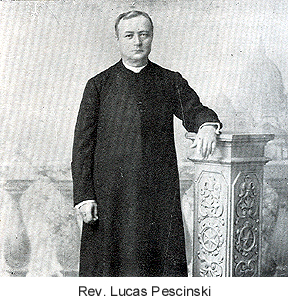 Father Pescinski rented the residence at 511 North Second Street to serve as a rectory. He lived there for several years, until the parish acquired a house in the 400 block of Fourth Avenue.
Father Pescinski rented the residence at 511 North Second Street to serve as a rectory. He lived there for several years, until the parish acquired a house in the 400 block of Fourth Avenue.
The new pastor, in his middle thirties, and a priest for about twelve years, came with great determination and tireless energy. In slightly less than a year after the conflagration, construction was started on a new church.
The plans were drawn by Mr. Bernard Kolpacki, a Milwaukee architect, and the contract for construction was awarded to Mr. Joseph Hutter, of Fond du Lac, for the sum of $15,150. However, improvements in the structure, pews, altars and a new organ, brought the total cost up to about $24,000. The building committee consisted of the pastor; Father Pescinski, the church officers; Michael Friday and John Biesik, and committeemen; Joseph Glinski, August Kostka, Anthony Kirsling, and Joseph Friday.
Evidently, the committee and the congregation worked very hard to finance the building project. It is surprising to read of the many collections that were made in an effort to reduce the debt of the parish. Townspeople of every creed and nationality contributed generously to help along the cause. We find collections for the clock, for the church building, for the bells, for the organ, and other items for the furnishings in the church. Parishioners individually bought stained glass windows, statuary, vestments and other furnishings. The church societies as a group, bought many of the more expensive fittings. The Men's Society and the Rosary Society bought the main altar. Father Pescinski donated one of the stained glass windows himself.
The corner stone was laid on July 11th, 1897, and was blessed by Rev. J. J. Fox, then the Vicar General of the Green Bay Diocese.
The structure rose rapidly after the corner stone was laid; so fast in fact, that the blessing of the church was scheduled for December 19th. How proud these people must have been! Now they had a beautiful church, substantially built of stone and brick; the most imposing church in Stevens Point! Truly a monument to our forefathers, that will attest to their strong faith and boundless courage as long as the building stands! It was dedicated to the greater glory of God on December 19th, 1897.
At ten o'clock that Sunday morning, the Men's societies of the parish, attired in their full regalia, assembled before the rectory and escorted the bishop and many priests to the newly completed church. (We translate from the "Rolnik"of December 24, 1897.) "His Excellency, Bishop S. G. Messmer, with many priests and members of the congregation, marched around the perimeter of the church, blessing the walls with Holy Water. The procession, followed by throngs of faithful, entered the center aisle of the church, where the bishop blessed the interior of the building. After the blessing, he delivered a beautiful sermon in English, interpreting the meaning of the blessing ceremony, and exhorting the virtues of peace, harmony, and brotherly love. After the Solemn High Mass, and the reception of the Holy Eucharist by the Men's Societies, Rev. P. Szulerecki of Milwaukee, preached a sermon in the Polish language."
"On Saturday evening preceding dedication Sunday, Bishop Messmer blessed two new bells which were to be erected in the bell tower. Sermons were preached in two languages at the ceremony; in English, by Rev. Rainer, the president of St. Francis Seminary; and in Polish, by Rev. Grenbowski, who is the pastor of Sacred Heart Church in Polonia. Many who were in the large crowd that attended, rapped the bell with a hammer, and offered a monetary donation toward payment of the bells. Immediately after the blessing ceremony, the bells were hoisted in the belfry, and were rung continuously for about an hour, until nearly midnight."
The church was heated with a furnace, using wood as fuel. (We find many entries in the financial records showing amounts paid to members of the parish for countless cords of wood.) The interior of the church was not decorated, but the graceful lines of the design and architecture created a very pleasing beauty. Sturdy pews of oak were installed in four rows, thereby forming four aisles. The sanctuary was elevated above the floor level of the nave, and contained the main altar and two side altars; each centered in three Gothic arches. Ingrain carpet covered the hardwood floor in the center aisle.
The Winter of 1897-98 was a busy one for the parish. Father Pescinski distributed First Holy Communion to a class of 72 children on Christmas day. This was the first group to receive the Eucharistic sacrament in the new church.
On February 20th, the new pipe organ and new Stations of the Cross were blessed. The organ was a fine instrument, costing over $1,600.00. A two-manual type, the organ produced combinations of tone that were very pleasing. In later years, the organ was sold to St. Bronislawa's parish in Plover, where it is still being used in the church services.
Rev. Leo Jankowski, a newly ordained priest, said his First Holy Mass in the church on February 22nd. He was the first "Native Son" of the Parish to offer Mass in the new church.
The first class to receive the Sacrament of Confirmation in the new church consisted of 143 persons. This event took-place on December 4th, 1899.
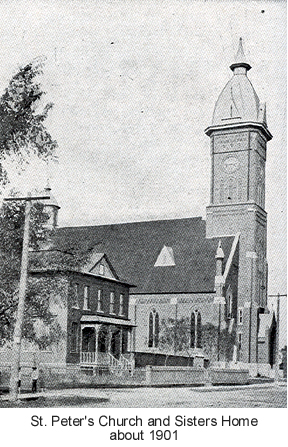 Early in 1901, plans were being formulated for a celebration of the Silver Jubilee. The parish, surviving what proved to be the most turbulent twenty-five years in its history, now owned a new church, a three-room wooden school building, attended by 241 pupils, a brick home for the sisters who taught in the school, and St. Peter's cemetery near the river.
Early in 1901, plans were being formulated for a celebration of the Silver Jubilee. The parish, surviving what proved to be the most turbulent twenty-five years in its history, now owned a new church, a three-room wooden school building, attended by 241 pupils, a brick home for the sisters who taught in the school, and St. Peter's cemetery near the river.
Although the parish labored under considerable debt, it was growing steadily, and was able to reduce the amount owing in a satisfactory manner. During the jubilee year, the membership embraced 434 families. Under the system of membership at that time, the head of the family paid an annual pew rental, the others in the family unit having no obligation to contribute toward the upkeep of the parish, if under twenty years of age. Many of them, however, did make donations for special purchases or events.
On June 23rd, three Resurrection Fathers opened a mission which began the Jubilee Celebration. The mission continued throughout the week. Many priests were invited to assist in the Jubilee Services, including Rev. Anthony Bogacki, the first pastor of the parish. Father Bogacki, who was in East Tawas, Michigan, was unable to attend. The mission was very well attended, attracting more than three thousand people to the Holy Sacraments during the week.
Bishop Messmer, and his vicar-general, Msgr. J. J. Fox arrived on the Green Bay and Western Railroad on Saturday, June 29th, at 9:30 p.m. Many members of the parish were on hand to meet the train, among them being the men's and women's societies in a body. Rain which was falling, failed to dampen the enthusiasm of the crowd. They spontaneously formed a procession, marched down Main Street to the Public Square, thence down North Second Street to the church, where the bishop blessed the assemblage in Solemn Benediction.
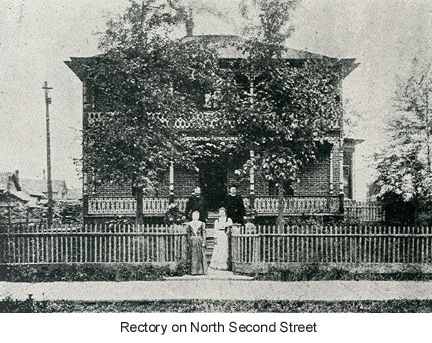 At 10 o'clock Sunday Morning, the Bishop celebrated a Solemn Pontifical High Mass. Seventeen priests were in the sanctuary, along with four seminarians; two of them being Francis Nowak and Michael Klosowski. The sermon was preached by Father Kosinski, one of the Resurrection Fathers who had conducted the mission.
At 10 o'clock Sunday Morning, the Bishop celebrated a Solemn Pontifical High Mass. Seventeen priests were in the sanctuary, along with four seminarians; two of them being Francis Nowak and Michael Klosowski. The sermon was preached by Father Kosinski, one of the Resurrection Fathers who had conducted the mission.
At three o'clock in the afternoon, Bishop Messmer administered the Sacrament of Confirmation to a class of 325 persons. Father Zapala, another of the missionaries, conducted the catechism questions and religious instructions.
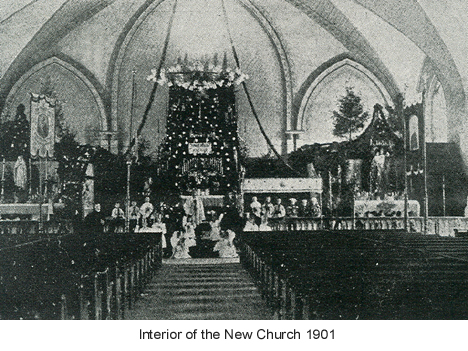
In the evening, vespers were sung, and a sermon was delivered by Father Ziemba, the third missionary. Immediately after Vespers, the mission cross was blessed, and carried in solemn procession through the church and into the narthex, where the cross was permanently stationed. After reading a telegram from Rome, delegating special permission, the bishop administered the Papal Blessing upon the congregation, bringing the Silver Jubilee Services to a glorious close.
